|
Naval Task Forces
and Commanders |
Western
Rear-Adm A. G. Kirk USN |
Eastern
Rear-Adm Sir P. Vian RN |
|
Assault Phase |
Warships |
Warships |
|
Battleships |
3 US |
3 RN |
|
Cruisers |
10 (5 RN, 3 US, 2 French) |
13 (12 RN, 1 Allied) |
|
Destroyers
& escorts |
51 (11 RN, 36 US, 4 French) |
84 (74 RN, 3 French, 7 Allied) |
|
Other warships, incl. minesweepers & coastal forces |
260 (135 RN, 124 US, 1 Allied) |
248 (217 RN, 30 US, 1 Allied) |
|
Total Warships |
324 (151 RN, 166 US, 6 French,
1 Allied) |
348 (306 RN, 30 US, 3 French,
9 Allied) |
|
Major Amphibious Forces |
Landing & Ferry Vessels |
Landing & Ferry Vessels |
|
LST, Troopships |
644 (147 RN, 497 US) |
955 (893 RN, 62 US) |
|
LCI(L) & other landing craft |
93 LCI(L) & 127 other (RN & US) |
116 LCI(L) & 216 other (RN & US) |
|
Totals incl. Warships |
1,188
|
1,619
|
|
Minor landingcraft (LCVP/LCA)
|
836 |
1,155 |
|
Total LCVP/LCA |
1991 |
|
|
Grand Total US & RN |
4798 |
|
For more on landing craft
CLICK HERE
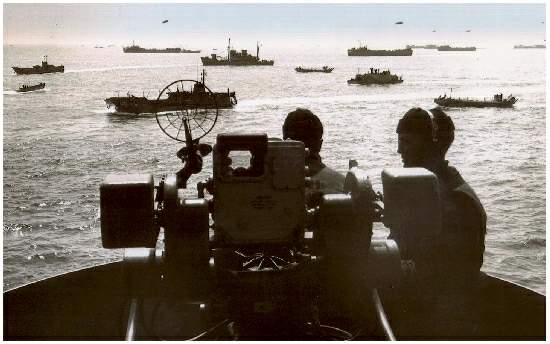
To this can be added the following:
(1) Home Command for follow-up escort and Channel patrols, plus reserves:
1 battleship (RN);
118 destroyers and escorts (108 RN, 4 US, 1 French, 5 Allied);
364 other warships including coastal forces (340 RN, 8 French, 16 Allied).
(2) Western Channel Approaches A/S Escort Groups and reserves:
3 escort carriers (RN),
55 destroyers and escort vessels (RN).
(3) Merchant ships in their hundreds - mainly British liners, tankers, tugs, etc to supply and support the invasion and naval forces.
(4) British 'Mulberry' harbour project of two artificial harbours and five 'Gooseberry' breakwaters including:
400 'Mulberry' units totalling 1.5 million tons and including up to 6,000-ton 'Phoenix' concrete breakwaters;
160 tugs for towing;
59 old merchantmen and warships to be sunk as blockships for the 'Gooseberries'. All were in place by the 10th June.
THE AIR FORCE ON JUNE 6th, 1944:
3440 heavy bombers, 930 medium bombers, 4190 fighters/
fighter-bombers, 1360 troop transport planes, 520
reconnaissance planes, 80 Sea/Air Rescue, 1070 Coastal Command
Total: 11.590 (6080 American and 5510 British)
3500 Gliders (Horsa, Hamilcar and
Waco)

Spitfire Mk
IX MK732, from No. 485 (RNZAF) Squadron, as it flew on D-Day
(restored and flies in Holland).
THE
STATISTICS IN NORMANDY
UNITS LANDED ON JUNE 6, 1944:
132.715 soldiers landed on June 6, 1944 on the beaches of
Normandy:
75.215 British, Canadian and French troops,
57.500 American troops
PARA DIVISION DROP ON JUNE 6, 1944:
23.490 paratroopers landed on Juni 6, 1944 in
Normandy:
7.900 British paratroopers (6th Airborne Division),
15.500 American paratroopers (82nd & 101st Airborne Divisions)
ALLIED LOSSES ON JUNE 6, 1944:
10.800 killed, wounded or missing (1/14)
(for details, see 'The Cold Statistics' below)
BROUGHT ASHORE VEHICLES:
438.491 vehicles were brought ashore (untill 31 august, 1944)
202.789 British and Canadian
235.682 American
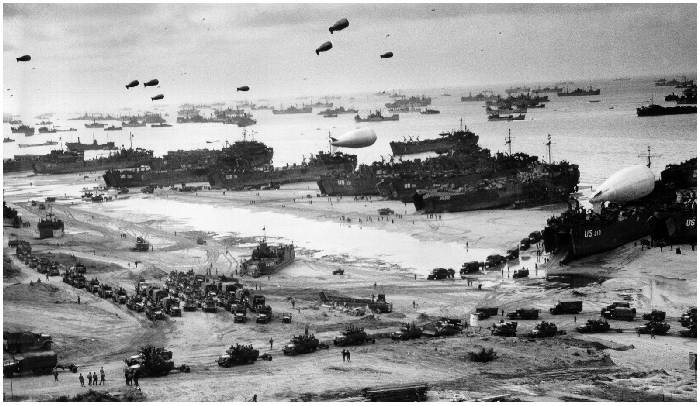
THE COLD
STATISTICS
In army terms the word 'casualties' is used.
One is to think that this covers the 'killed in
action' figures. This is not the case. That's why you'll find,
because of the confusing reports,
contradicting numbers for the losses during and after battles.
A 'casualty' of war means,
'no longer fit for battle', wounded, killed or missing. In that
perspective it shows that the losses in human life were less
dramatic than sometimes pictured. Below are the numbers of
casualties in the first days during and after the landings in
Normandy (on the Allied side). As you may notice, the list of missing is
enormous. Still to this day, human remains are found. But in most cases,
the missing men will never be found, they were simply wiped of this earth by bombblast,
or incinerated by fire.

6 June 1944:
For years the exact number of victims of the Allies was uncertain.
The US National D-Day Memorial Foundation did an inquest
and the number was much higher then ever was thought.
The Foundation checked all the Allied troops that were killed on the 6th of June 1944,
during Operation Overlord. It has been confirmed that 2501 Americans were killed on D-Day, 3184 wounded and 1928 missing.
With the 1913 killed of the other Allied nations the death toll is 4414 dead (and the number
will increase when the still missing are counted into it).
|
LOSSES |
KILLED |
WOUNDED |
MISSING |
TOTAL OUT OF ACTION |
|
TOTAL USA |
2501 |
3184 |
1928 |
7613 of 57.500 |
Losses seaborne troops
|
SECTOR |
KILLED |
WOUNDED |
MISSING |
TOTAL OUT OF ACTION |
|
OMAHA |
1000+ |
2000 |
1017 |
4000+ of 34.250 |
|
UTAH |
137 |
500 |
60 |
700 of 21.000 |
|
JUNO |
340 |
574 |
250 |
1200 of 21.400 |
|
GOLD |
350 |
--- |
--- |
1050 of 25.000 |
|
SWORD |
300 |
--- |
--- |
1000 of 28.845 |
Losses airborne troops
|
LOSSES |
KILLED |
WOUNDED |
MISSING |
TOTAL OUT OF ACTION |
|
82nd AB. Div. |
84 |
936 |
200 (10 POW) |
1235 of 7534 |
|
101st AB. Div. |
137 |
482 |
2000 |
2619 of 8451 |
|
6th AB. Div. |
600 |
--- |
600 |
1200 of 7900 |
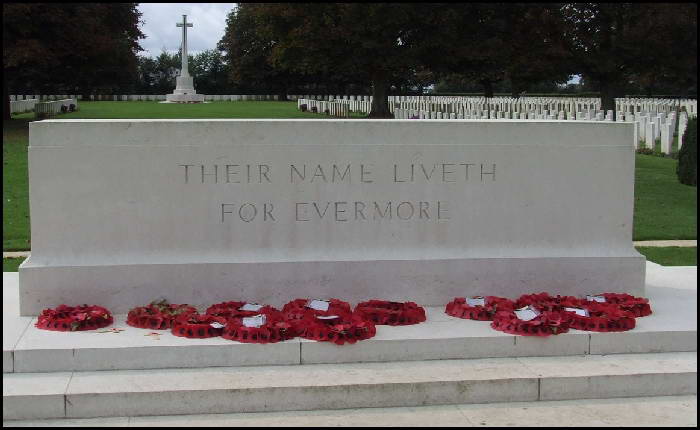
As the above shows, the figures are still approximate.
For example, what I did not include are the
glider pilots, of which about 100 were reported to have been lost during the landings. Sometimes those figures
are included in the airborne, and not mentioned in other sources. That the figures also approximate
is also due to the fact that the army sometimes started to make up the losses days after the landings,
and during those periods some of the
missing people returned to their units, others stayed away forever and others were prisoner of war with the Germans.
Below is another figure of Omaha Beach, recorded four days after the landing.
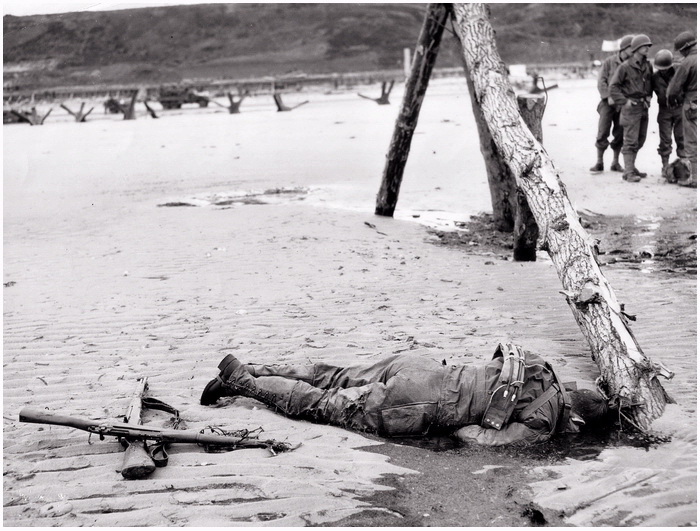
Maybe the most
heartbreaking picture from Omaha Beach
From 6 June to 10 June, 1944, D-DAY +
4:
101st Airborne Division, consisted of 8451
paratroopers.
137 killed, 482 wounded, 2000 missing, a
total on casualties: 2619 men
82nd Airborne Division, consisted of 7534
paratroopers.
84 killed, 936 wounded, 200 missing, 10 made
prisoner, a total on casualties: 1235 men
OMAHA BEACH D-Day + 4
1st Infantry Division: 124 killed, 1083 wounded, 431
missing, a total on casualties: 1638 men
29th Infantry Division: 280 killed, 1027 wounded, 890
missing, a total on casualties: 2210 men
Other units on OMAHA Beach: 148 killed, 656 wounded, 599
missing, a total on casualties: 1373 men
The American forces lost during the first four days, 5221
men on OMAHA Beach alone.
From 6 June till 20 June, 1944:
US First Army lost 24.126 men: 3082 killed, 13.121 wounded
and 7959 missing.
The British lost 13.572 men: 1842 killed, 8599 wounded and
3131 missing.
The Canadian lost 2815 men: 363 killed, 1359 wounded and
1093 missing.
THE GERMAN
CASUALTIES
After intensive investigations it is impossible to give
exact figures on the German losses in the first days after the
allies landed in Normandy. The figures range from 4000 to even
9000. A report from Erwin Rommel, end of June,
speaks of the losses in that month of '28 Generals, 345
commanding officers and about 250.000 men'.
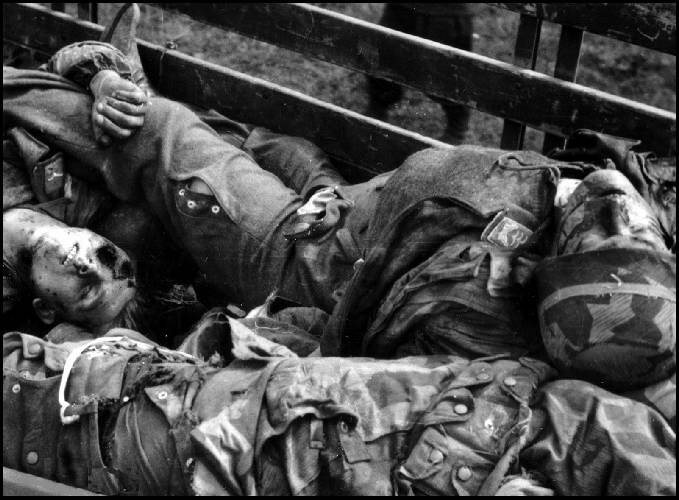
Killed German para's of the
6th Fallschirmjager Regiment
The total losses from June 6th, 1944 till 22 August, D-DAY
+ 77 on the Allied side where; 200.000 men, among them almost
37.000 killed.
Under the French population there were at
least 100.000 victims, civilians and Résistance.
Together
with the German losses, about 400.000, the total figure on
casualties run around the 700.000 men in 77 days of battle. In
perspective, the Battle of the Somme, one of the bloodiest
from the First World War, that was fought over a period of 141
days, the losses were at least 1.250.000 on German, British
and French troops. In comparison, the Battle for Normandy was
just as bloody as the fighting on the western front in the
First World War.
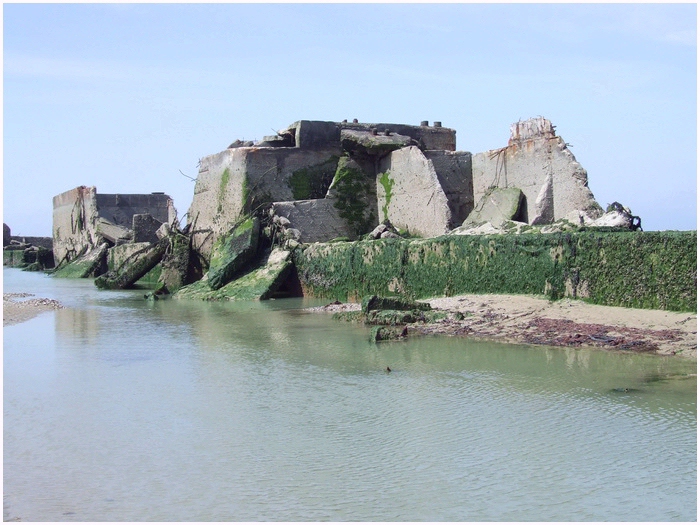
Symbol of wars,
perishable objects as a memory,
the Mulberry Harbour is slowly rotting away
back